After my previous post talking about sleep tracking apps, I decided to bite the bullet and go buy a Fitbit. I went with the Fitbit Charge HR as I wanted one that monitored my heart rate. I’ve previously used a heart rate monitor in a gym, which made me feel very unfit when I saw how high my heart rate goes when I run. I think that it would be interesting to see how my heart rate is now, and to be able to see how my resting heart rate changes as I get fitter.
So, I went out and bought the Fitbit last Sunday. I had a Taekwondo session scheduled for that evening, so I charged up the Fitbit and wore it there. My first issue with the Fitbit is that it doesn’t really provide you with instructions on how to do things. I’ve had to Google search various things that I’m trying to do, and read Reddit threads of people having the exact same issue to work out the solution. I’ll talk about these issues later, as a vague guide to new users. I downloaded the companion app (Fitbit on the Android app store), which provides a user interface to view data collected by the Fitbit. The Fitbit communicates with the app via Bluetooth, and also comes with a little USB Bluetooth dongle if you’d rather pair it with your PC. Paired devices seem to auto connected/sync. The screen on the Fitbit is pretty tiny and has only one button, so to view the data on it you need to keep hitting the button to tab through everything, making the app very useful. The Dashboard of the app gives a summary of all data collected:
The first thing that jumps out here is that the calories burned is quite high considering I’ve been largely sedentary this morning. The app asks users to input their height and weight, and based off of this it calculated how many calories they burn just from existing. It takes this value in to account when working out calorie expenditures for a day (in addition to calorie usage from exercise). This screenshot was taken at 10:44, so I probably burn just shy of 70 calories an hour in maintaining my mass. The calorie target (the 2,000 in grey to the side of this field) can be manually set, as can all of the target rates.
In the above screenshot, my heart rate (measured in bpm, beats per minute) is displayed as –. This is because the Fitbit is currently on charge, i.e. is not being worn by me. When starting the app initially you are prompted to create a Fitbit account, requiring a valid email address. I discovered this morning that not only does the app alert you that the Fitbit’s battery is low, it will also send you an email. The value under the current heart rate is the resting heart rate. This seems to be calculated on a daily basis, seemingly while you sleep. Getting this functionality to work was a major source of confusion for me. When I first put on the Fitbit/paired it with the app I could see my heart rate on the Fitbit itself, but not on the app. I Google searched the problem, and found other people with the same issue. Apparently, if you are using the app on Android, the HR won’t live sync to the phone unless you have call notifications enabled for the app. A guide to turning this on can be found on the Fitbit website, but it is not indicated anywhere within the app that this is a requirement. It also seems a very intuitive thing to need to do, so you may want to make sure you’re good at using search engines before you invest in a Fitbit! You may also have to turn all day sync on manually, as the default is “automatic”. Once I finally got the live heart rate display working, I expected the Fitbit to be able to calculate my resting heart rate. It did not, as that would have been simple. Spending some time searching Reddit discussions of other people with the same issue I learned that the Fitbit generally needs to be worn while sleeping to be able to calculate the resting heart rate. Wearing it overnight did indeed prompt this calculation. Again, this was not indicated within the app at all.
So, now that I had my heart rate syncing correctly (but still no resting heart rate), I went to Taekwondo. I did two hours of training, at various intensities depending on what we were doing at the time. I checked the Fitbit via the scrolling screen button randomly throughout, and found that my heart rate looked a bit lower than what I’d expected. After the session, I tried to view my heart rate for the day, but could not find a way to do so. When I tried touching heart rate on the dashboard screen of the app, I was shown a blank screen that read “no measurements”. I yet again spent some time Google searching for why this was the case, and found that it stemmed from not having a resting heart rate calculated. Upon pressing heart rate, you are shown a display such as this:
This shows your resting heart rate over the past few days. If you scroll down, you can then touch to view your heart rate over the course of the day. As I did not have a resting heart rate for the first day, the app had nothing to show in the initial graph. Because there was nothing to show, it did not load this screen (instead just saying “no measurements”). Because it did not load this, it didn’t load the daily heart rate graphs at the bottom of the screen. The data was being stored, but was inaccessible until after the Fitbit measured my resting heart rate. Great design. On the dashboard screen, if you hit “Track your exercise” you are taken to the exercise log screen. This allows for you to keep track of what exercise you’ve done, and keeps a calendar of which days you have/haven’t exercised on.
I’d seen screenshots online of heart rate graphs for an exercise, so I added the Taekwondo session, specifying the times during which it had taken place. I hoped that this would link up with the heart rate data and allow me to access it.
Evidently not. This confused me very much, due to the graphs I’d seen. I did yet another Google search to try and work out what had gone wrong. Apparently, before you begin an exercise, you should hold the button on the Fitbit down for a couple of seconds until a timer symbol appears. This causes the Fitbit to begin recording an exercise. When you finish exercising you hold the button until a flag appears. This is then added to the exercise log, and can be seen in the screenshot before last as “Workout” entries. A graph of my Lacrosse training session/match yesterday can be seen here:
The exercise duration was 1hr 50 mins, but according to the screenshot I only spent 1hr 17 mins in the exercise zone. This is based off of the idea of target heart rates for various types of exercise. You maximum heart rate should be 220 minus your age, so in my case 197. Having within around 50-85% of your maximum heart rate is seen as being good for exercise, with different heart rates apparently corresponding with different body behaviors. According to this graph I spent most of my time in the fat burn zone, and from the graph you can see that my heart rate did not go very high. I have seen this in numerous recordings being made by the Fitbit, that my heart rate seemingly does not go above ~130bpm. From previous heart rate monitorings, my heart rate can and does go above this during exercise. From quickly checking my pulse during exercise, my heart rate seemed to be above what was being measured. I am unsure if the heart rate monitor of the Fitbit is generally poor, or if I have a defective model. Fitbit provides a guide on correct Fitbit placement, which I have been adhering to. To try and highlight the issues with the heart rate tracker, we can take a look at my heart rate for the entire day. As I gained a resting heart beat measurement over night, I can now actually access such graphs.
You can see that generally my heart beat peaked around the same point. The only time that it rises in to the cardio zone and goes quite high is the time in which the Fitbit was sat on my desk as I was in the shower. It seems bizarre that the Fitbit would make this interpretation about being left on a desk. There’s a break in the line during this peak, perhaps for a brief moment the Fitbit considered if a desk should have a pulse. The area of peaks to the left of this spike is my Lacrosse session. The series of peaks to the left of this (around noon) was me walking to meet someone across campus. The peak to the left of this (pre-noon) was me eating a tasty snack. As much as I enjoy junk food, I assure you that it does not get my heart rate up as much as running across a pitch waving a stick does; the same goes for the physical exertion needed to walk for 10 minutes. It seems that the Fitbit just won’t record above a certain point. It’s possible that all three of these activities raised my heart beat above ~120 (it was a really tasty snack), and at this point the Fitbit ceased in measuring anything higher. It must be capable of recording above this level as it recorded the desk as being around 150bpm, so I’m really not sure what caused this. It seems that the Fitbit behaves like this when ever taken off while I shower. Earlier I mentioned the issues of recording my heart rate during a Taekwondo session, and that the heart rate for this was stored yet not accessible. Once I gained the resting heart rate I was able to access it, but in an odd way.
When I go to the heart rate log screen, Sunday does not appear in the graph. Upon scrolling down, it does not appear.
However, I can click the day after it’s graph.
By clicking the square in the top right of the graph (or just by touching the graph, making the symbol sort of redundant), I can enlarge it.
From this screen, I can swipe left to view the next day’s stats. But look, I can also swipe right!
And so, I am able to view Sunday’s heart rate.
A shower heart rate can be seen here, taking very much the same shape as it did on Tuesday. The peak to the left of it is my Taekwondo session, again not rising nearly as high as it should have done. However, it seems very odd to me that this couldn’t be combined with the manually added exercise. When adding the exercise I was asked to specify the times at which the exercise began/ended. Heart rate measures are time-stamped. Why is it so hard to combine these two? Why is it so hard to even get at this first set of data? Going back to the exercises recorded via the exercise mode on the Fitbit itself, there doesn’t appear to be a way to change the title to indicate what exercise I had done. Why is it seemingly impossible to have a hear rate metric assigned to a name exercise? A lot of the design decisions that have been made in the development of this app make little sense to me.
Going back to what prompted me to look in to buying the Fitbit (and was the subject of my previous post)- sleep tracking. The Fitbit can either automatically attempt to automatically detect if you are awake or not based on your movements (for instance, I was apparently asleep while writing this post), or via manually telling the app when you sleep. I had taken my Fitbit off to charge while writing this post, which triggers the heart rate monitor to switch off. I’m not sure why the lack of pulse made the Fitbit think that I’m asleep instead of dead.
Within the app, manually adding sleeps can be done in two ways: you can either provide the app with a time range during which you are asleep, or you can press a button when you go to sleep and again when you are awake.
During this sleep time, the Fitbit tracks your activity to provide some calculations.
As with the other apps, the app seems to identify my times of being awake as just being restless. However, I imagine that it’s quite hard to differentiate the two really. Interestingly, the app counts how many times that you were restless and the total duration of these periods. In my case on this night I was restless 16 times, and spent about 42 minutes awake and/or restless. This value seems to include the time taken to get to sleep. It seems like an interesting feature for working out how long I need to sleep however. Although I was in bed for 8hrs32mins, I only got 7hr50mins of sleep. I found that I felt quite tired in the morning, suggesting that I need to be allotting larger amounts of time to sleep.
The following night however, I slept even worse:
I had to be up earlier in the morning, so I tried to go to bed a little earlier to compensate. Apparently my sleep deficit from the night before was not sufficient for me to push my sleep back, as I struggled quite a bit to get to sleep. I was awake/restless 18 times, totalling to 73 minutes. This is interesting as I don’t remember waking up too many times (maybe 3 times). It seems that these periods of restlessness and wakefulness are strongly correlated, and that it doesn’t really impact how I feel in the morning if I am awake or simply restless. Needless to say I felt quite tired on the morning after this sleep.
On night three of having the Fitbit, I once again went to sleep around 23:30 in the hope of pushing my sleep patterns back. I’d hoped that the lack of sleep the past two nights would make it easier to sleep, but it seems to have not had much effect:
In this sleep I was awake/restless 18 times again, totally to 53 minutes. I once again felt tired upon waking up. Frustratingly, it seems that if I sleep (read: be in bed trying to sleep) long enough to feel restful in the morning (~10 hours), then my body will not let me sleep at a reasonable time the following night. I seem to have to constantly be at a deficit throughout the week to maintain my sleeping patterns, having a binge sleep at the weekend which I then need to counter for by sleeping a small amount the next night. I once read about Michel Siffre, a man who spent substantial amounts of time living/researching in caves with no daylight. Without any daylight to set the timings of days and no clocks to self-regulate by, his natural body rhythm shifted to having “days” that lasted longer than 24 hours. He comments that a lot of people he worked with adopted 48 hour days, spending 36 hours awake followed by 12-14 hours of sleep. It would be interesting for me to see how well I could sleep on a rhythm such as this one, but it seems quite unfeasible for me to be able to do so. Still, I have been enjoying viewing metrics of my sleep and the Fitbit does seem to be a superior way to track it than the previously used apps!
An interesting aspect of Fitbit use is the social side. Sam has also purchased a Fitbit (the same model as me), and we are now friends on the app. The app creates a profile for you, awarding “badges” for meeting certain criteria (such as walking X steps in a day), and allows you to view the average number of steps per day being taken by friends. It also links with Facebook/Google+ for ease of finding friends, although you can manually add a friend using their email address. An interesting piece of functionality that comes with having friends is that of duels- your statistics in a given area are recorded and compared to those of a friend (if they accept the duel). The app provides you with updates throughout the day on how you are each performing (including any badges earned), although you can also see the raw numbers.
You can also “cheer” for friends, and send them direct messages. These actions all seem to generate alerts however, and so it can get a bit spammy.
A key piece of functionality that Sam has been interested in (but not so much myself) is the calorie tracker. We both recently downloaded MyFitnessPal, an Android app that helps you track calories. You can scan in the barcodes of items, search a huge database of already listed items, or manually add items. It can be used to work out your “macros” (making sure you get for instance enough protein in a day), as well as calories. I already habitually check calories on foods and am well aware of how unhealthily I generally eat. For Sam however I think it was a learning experience. He has decided to keep tracking calories with the help of the Fitbit app, while I have not. As such, the following screenshot comes from his device:
This does seem to be quite a good way of tracking calories, as it compares the amounts with your calorie expenditures. I’ll not attempt to make excuses as to why I am not also taking this up, I am simply lazy to do it.
In general, I’m happy with my Fitbit. However, I will be contacting support about the heart rate tracking issue, and potentially attempting to exchange it for a new one if the problem cannot be fixed. I really would like to be able to track my heart rate, and with the price hike associated with getting a Fitbit that is capable of tracking heart rate, I’d really like one with a monitor that’s actually usable!

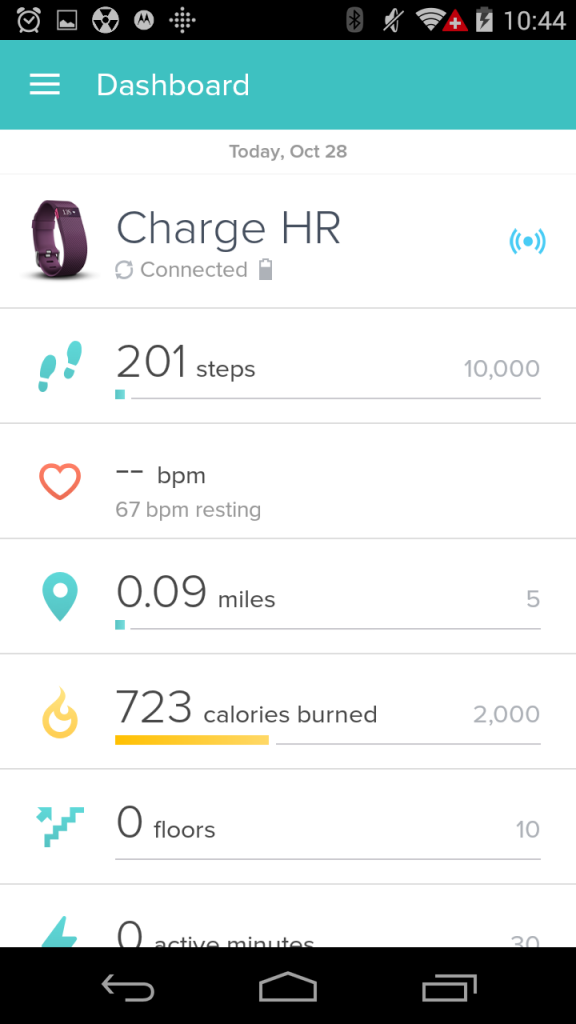

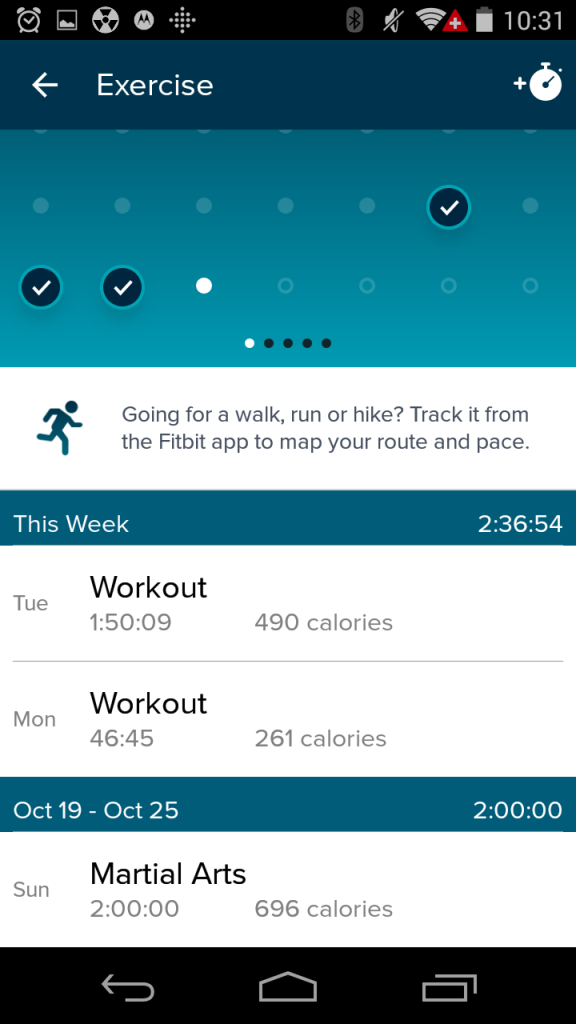


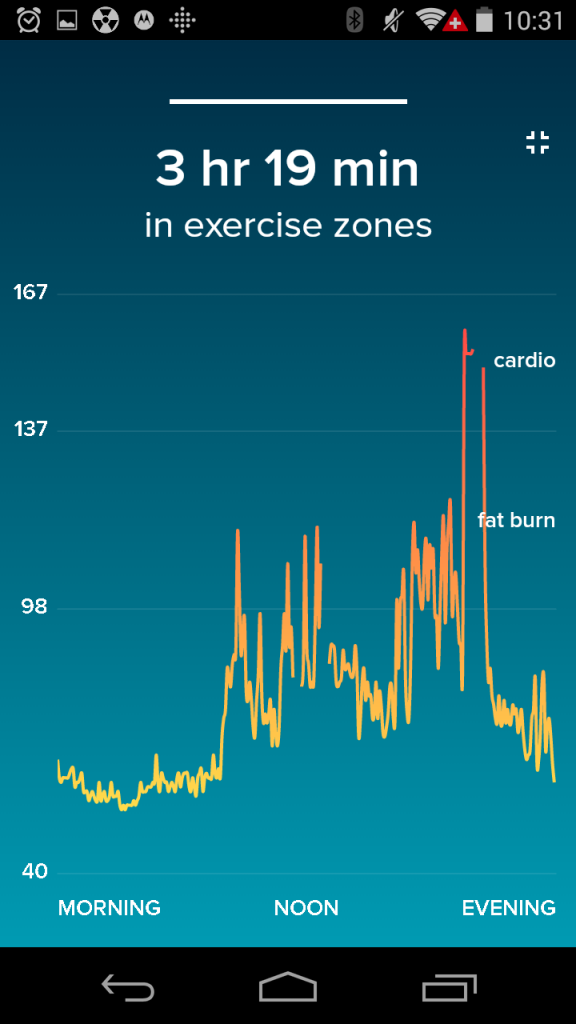

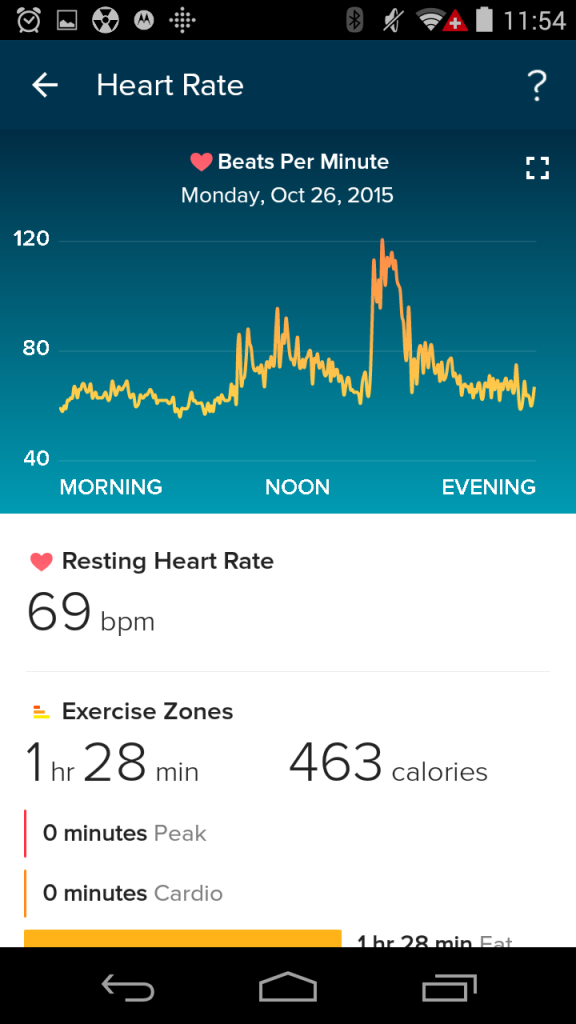
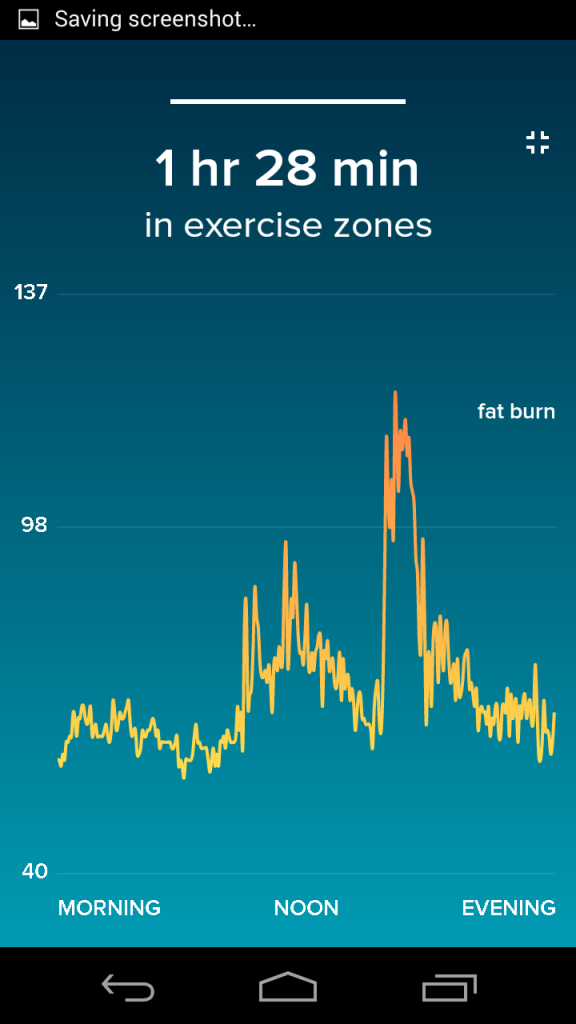
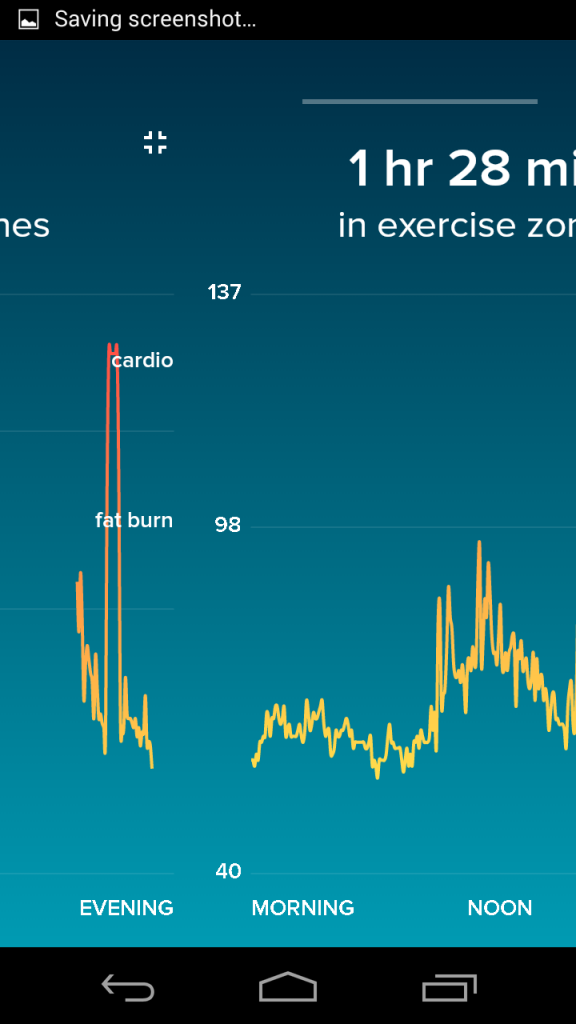

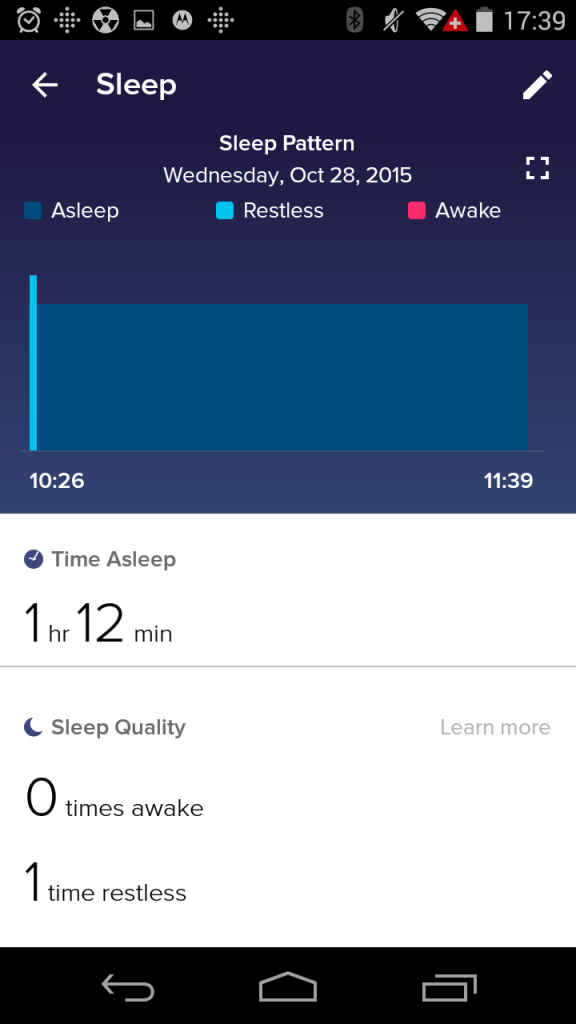
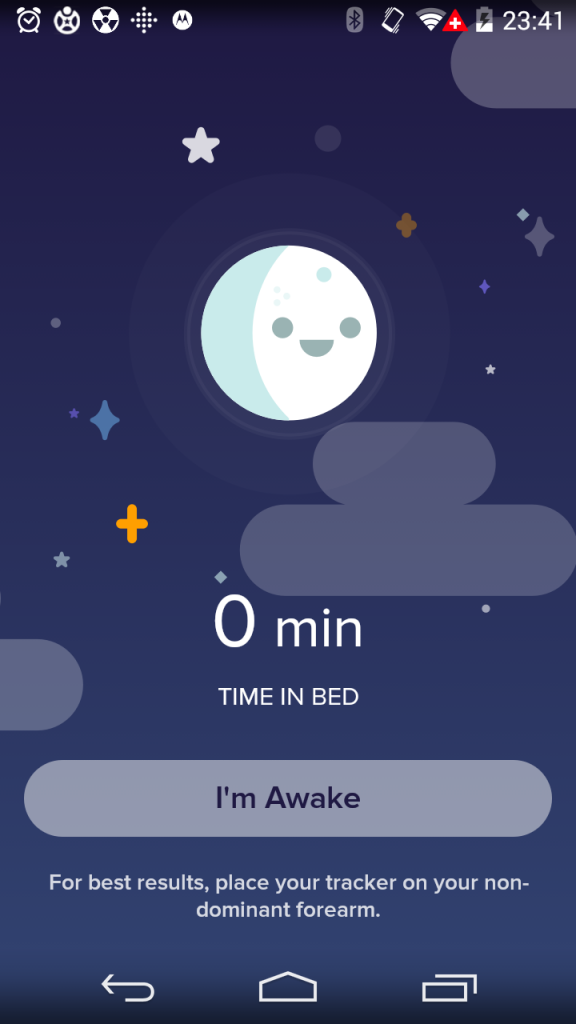






[…] I had been thinking of acquiring one for a few months now. The purchase was primarily motivated by my partner’s latest pursuit for improved fitness, but I guess any excuse for self-quantification is a good one […]